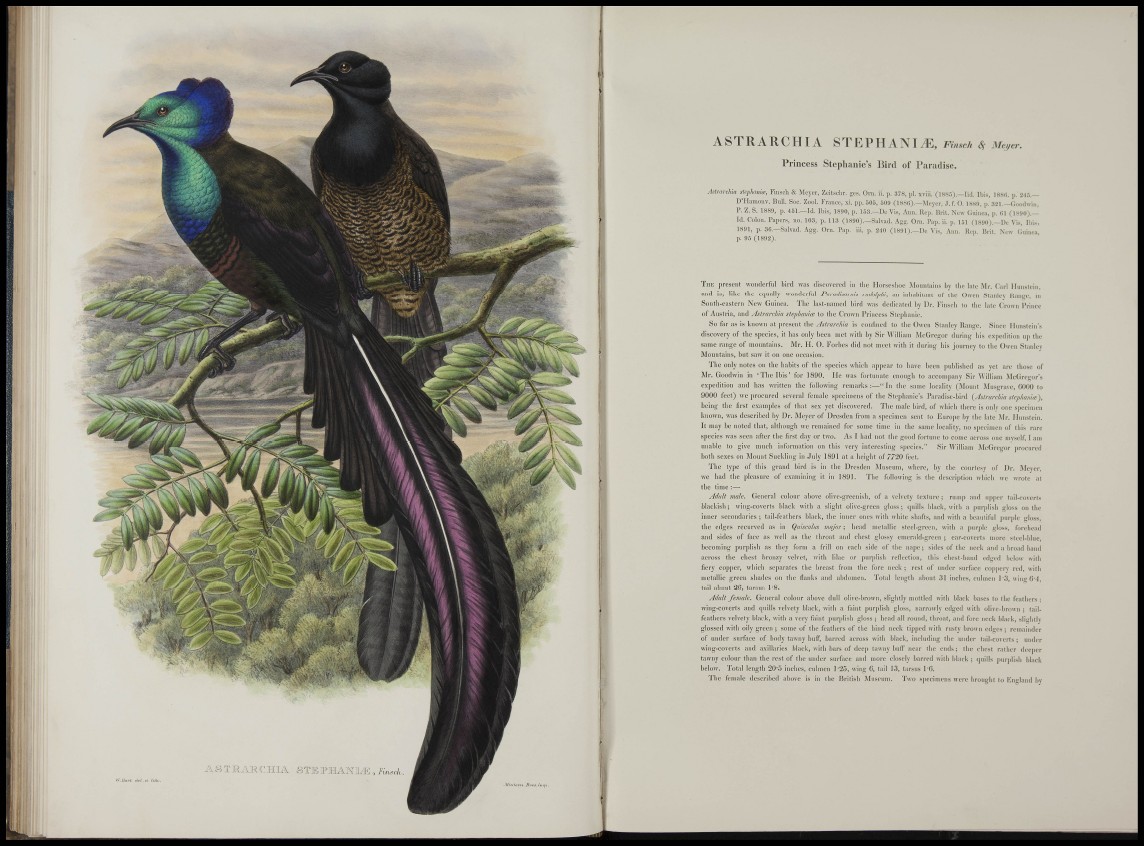
¡i 'l'I
•I I
ASTRARCHIA STEPHANI/E, Finsch Me,jer.
Princess Stephanie's Bird of Paradise.
AstrarcMa stepkmia, Filiseli & Meyer, Zeitsclir. ges. Oni. ii. p. ;ì78, pi. xviii. (1885).—lij. Ibis, 188(1. p. ^l.",.—
D'llaraoiiv. Bull. Soc. Zool. Fiimce, xi. pp. 505, 50!) (1886).—Meyer, ,1. f. 0 . 188!), p. aai .—Goodwin,
P. Z. S. 188!), p. 451.—Id. Ibis, 1890, p. 1.5;!.—IJe Vis, Ami. Rep. Biit. New Cuiliea, p. 01 (ISilll).-
Id. Colon. Papers, no. 103, p. 113 (18!I0).—Salvad. Agg. Orn. Pap. ii. p. 151 (1H!)0).—l)e VU, Ibis,
18!)1, p. 30.—Salvad. Agg. Oni. Pap. iii. p. S-IO (18«ll).—De Vis, Ann. Hep. lirit. New (iuiliea,
p. !)5 (1803).
The ¡ii-eseiit woiiilci-ful bird was discovei-ed in the Hoi'seslioo Mountiiins by llii; late Mr. Cai'i llnnstuin,
and is, like tlie eciually wonderful Parm/isoniis ru(hlji/ii, an inluibifant ol' the Owen Stanli'v liani;e, in
South-eastern New Guinea. The last-naniecl bird was dedieated by Dr. Finseli to the hite Crown Prince
of Austria, and yhtrarclna sicphcmia; to tbe Ci-own I'rineess Stephanie.
So far as is known at j)i-esent the y/i7')Yi;r/«fl is eonlined to the Owen Slauley Kange. Siiiec Ilunstein's
discovery of the species, it has only been met with by Sir William McGregor during bis expedition u|i tlie
same i-ange of mountains. Mr. H. O. Forbes did not meet with it during his journey to the Owen Stanley
Mountains, but saw it on one occasion.
Tbe only notes on the habits of the species which appear to have been published as yet are those of
Mr. Goodwin in ' The Ibis' for 1890. He was fortunate enongh to aceoni|)auy Sir AVilliam McGregor's
expedition and has written the following remai'ks :—" lu the same locality (Mount Musgi-ave, G(MK) to
9000 feet) we jirocured several female siiecimens of the Steiihanie's Paradise-bird {Aslrurch'm stqilmma),
being tbe first exanijiles of that sex yet discovered. The male bii-d, of wliieh there is only one siiecinien
known, was desci-ibed by Dr. Meyer of Dresden from a specimen sent to Europe by the late Mr. lluustelu.
It may be noted that, although we remained for some time in the same locality, no sjiecimen of thi.s rai'e
species was seen after the first day or two. As I had not the good fortune to come across one )iiy.self, I am
unable to give much information on this vei-y intei-esting s|iecles." Sir William McGregor jn-ocured
both sexes on Mount Suckling in July 1891 at a beigbt of 7720 feet.
The type of this gi-and bird is in the Djesden Museum, where, by the courte.sy of Dr. Meyer,
we bad tbe pleasure of e.xaniiniug it in 1891. The following is tbe description whicb ive w)-ote at
the time :—
Adult male. Genei'al colour above olive-greenish, of a velvety textui-e ; rump and upper tail-coverts
blackish ; wiug-covei-ts black with a slight olive-green gloss ; quills black, with a purplish gloss on tbe
inner secondaries ; tail-feathers black, tbe inner ones with white shafts, and with a beautiful jnirple gloss,
the edges recurved as in Quiscalu.i major; head metallic steel-green, with a |iur|ile gloss, forehead
and sides of face as well as the throat and chest glossy cnierald-gi-eeu ; car-coverts more steel-blue,
becoming pui-|ilisb as they form a frill ou each side of the najie; sides of the neck and a broad band
aci-oss tbe chest bronzy velvet, with lilac or purplish rcfiection, this chest-band edged below with
fiery cojipcr, which sejiarates tbe breast from tbe fore neck ; rest of under surface copjici-y red, with
metallic g]-een shades on tbe llaidis and abdomen. Total length about .'il inches, culmeu 1-3, wing 0-4,
tail about 20, tarsus 1 -8.
Adult female. Genei-al colour above dull olive-brown, slightly mottled with black bases to the feathers ;
wing-coverts and (jidlls velvety black, with a faint purplish gloss, nanwly edged with olive-brown ; tailfeathers
velvety black, with a vei-y faint purjilisb gloss ; head all i-ound, throat, and fore neck black, slightly
glossed with oily g)-een ; some of the feathers of the bind neck tip]ied with rusty brown edges; remainder
of under surface of body tawny bulf, barred across with black, including tbe under tail-coverts ; under
wing-coverts and axillaries black, with bai's of deep tawny bulT near tbe ends; the chest i-ather deeper
tawny colour than the i-est of the under surface ami ino)-e clo.sely barred with black ; quills jiuqili.sb black
below. Total length 20-5 inches, cidmen 1-2.5, wing C, tail 13, tarsus I'O.
The female described above is in the British Museum. Two specimens wei'c brought to England by
a s t ] R A : R > Ì ! H ; L Ì V STJEPHAKIxE,
n-.lu,H liti, .